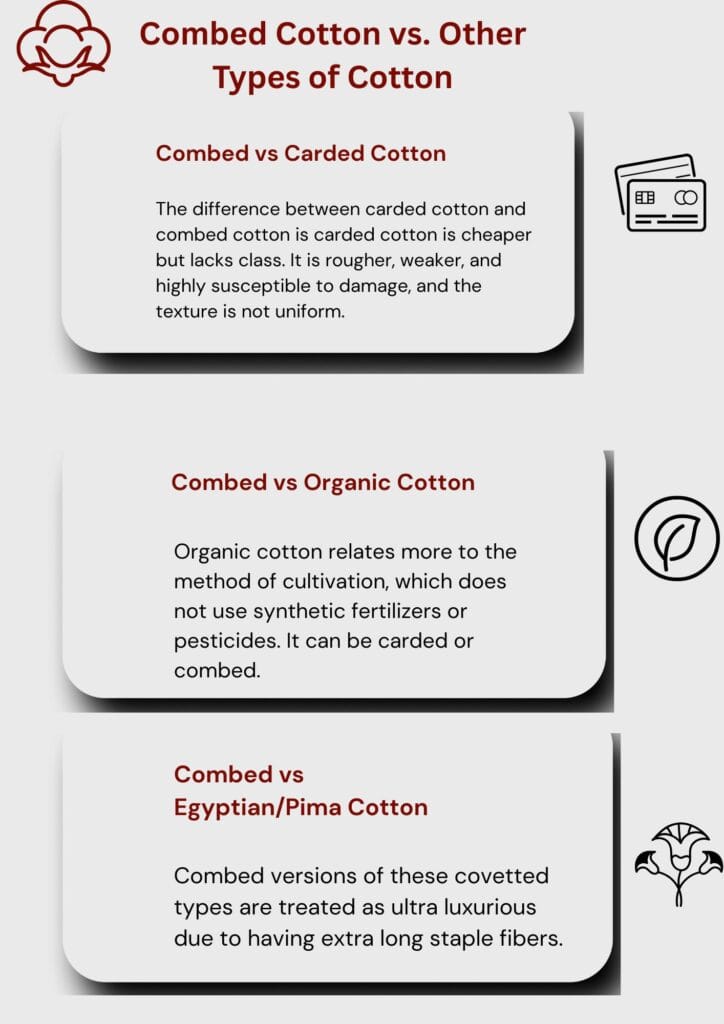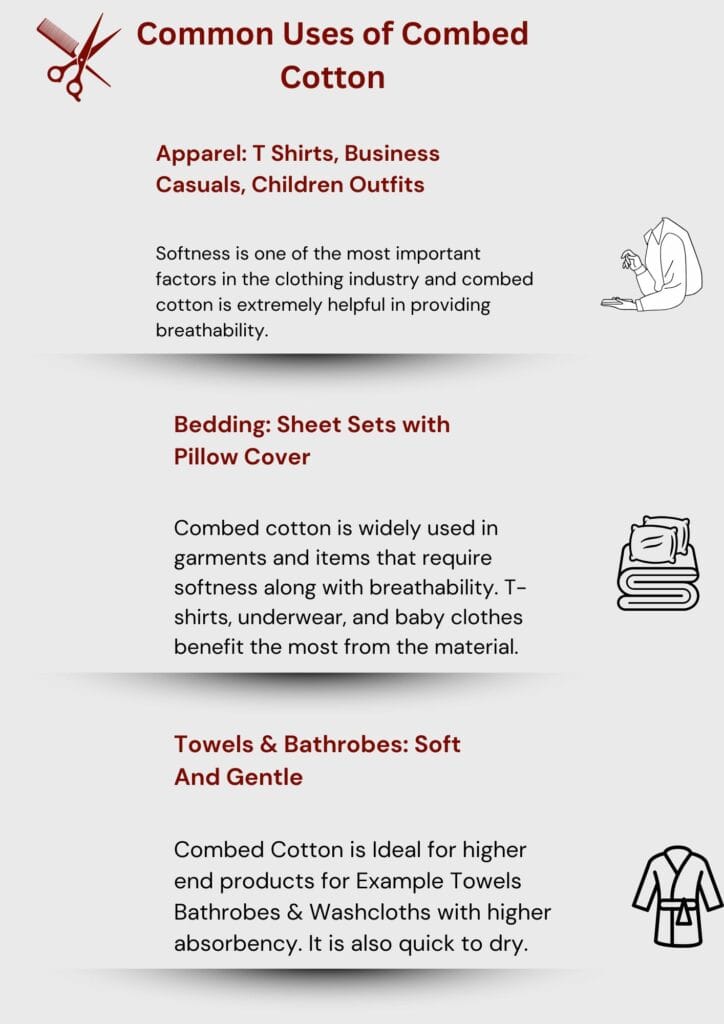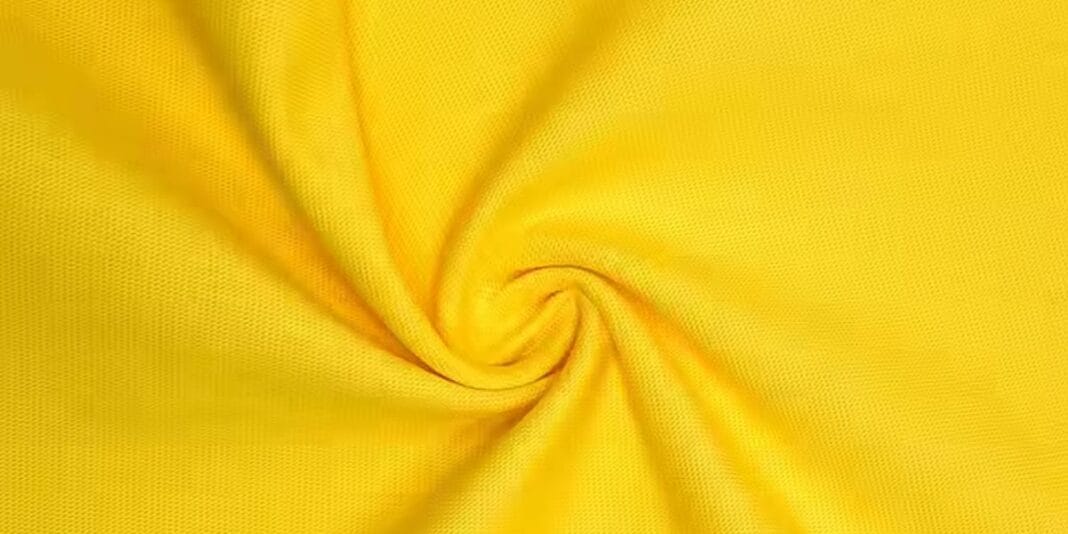Introduction
You may be wondering what is combed cotton? Combed cotton is a type of cotton fabric which goes through additional processes to remove short fibers and other impurities which makes the fabric smoother, stronger and more comfortable than standard cotton, hence luxurious and durable.
Combed cotton is used by many brand names for luxury bedding, baby clothes and fine clothing which shows its higher demand due to its quality in comparison to other types of fabric. Apart from softness, it is long-lasting, provides better performance and value making it an enhancer of many products.
Combed cotton comes from a special process known as combing in which ordinary cottons vex are transformed into extraordinary which becomes ideal for people who are seeking comfort and durability.
A Brief Definition of Combed Cotton
Combed cotton is produced from a special process of beating cotton ginned to separate short fibers and other impurities. After the cotton is ginned, it is carefully combed to remove short strands of fibers and any trash that is left over. This process transforms end product immensely soft and durable fabric adding to its value.
This type of refined cotton differs from other types of cotton. It is smoother on the touch and maintains its shape and quality after multiple washes. Because of its special properties, comfort combed cotton is often used in high quality textiles that focus on soft materials that can withstand the test of time.
How it differs from regular cotton
Regular cotton keeps all fibers as long as they are of any length. Combed cotton, however, separates the shorter fibers and fro combed cotton removes all shorter fibers. These shorter fibers are also known to break, pill and fray easily. Removing such fibers makes fabrics tougher and prevents easy damage.
While both types of fabrics serve their users, there are stark differences in performance and texture. While regular cotton might be give off a little fuzz and feel rough, combed cotton does not. It maintains a smooth surface, which is appealing to those seeking comfort and a reliable long-term experience.
Why it’s preferred over other types of cotton
Quality conscious customers go for combed cotton as it is more durable to low maintenance washing. Such products directly received the skin and were used more often leading to more wear and tear with the luxurious soft touch feel. Such items became a favorite for their sturdiness along with withstanding pilling which made these products last longer.
Combed cotton is preferred by many high-end apparel and bedding brands because it feels better and lasts longer. It is also gentle and ideal for those with flexible skin. Combed cotton is gaining popularity around the world for these reasons and more.
The Production of Combed Cotton: The Steps Involved in Making Combed Cotton
As with any product, understanding what is combed cotton requires looking into its production. The journey starts from harvesting and progresses to spinning. Every step is crucial in cultivating the refined and resilient fibers that characterize combed cotton.
Step-by-Step Explanation: Picking, Ginning, Combing, and Spinning
- Harvesting – For cotton, the picking can be done either through hands or machines. The harvest’s quality affects the end product.
- Ginning – This processes the collected cotton by cleaning its seeds, leaves, and other debris.
- Combing – This is the defining step. Short strands and impurities are removed through combing the fibers meticulously.
- Spinning – The fine yarn is the result of spinning the long combed fibers. This yarn is now ready to be woven or knitted into fabric.
All these steps ensure smoothness, uniform strength, and greater strength which set it apart as combed cotton.
Importance of Combing in Eliminating Short Filaments and Impurities
The importance of the process is the use of fine brushes to organize fiber which makes the weak ones to be eliminated out from the filament. So, the remaining fibers become consistent in length and strength which will result to reduced breakage and unevenness while spinning.
As a result, cotton’s durability increases making it harder to pill and smoother due to absence of loose filaments. This results in a comfortable wearing for garments and linens.
Relation to Carded Cotton
Carded cotton doesn’t carry out the combing process. Therefore, it retains all the long and short fibers which makes it more coarse. This can cause the fabric to become rougher and have a higher chance of pilling or fraying with time.
The lower price of carded cotton comes with a compromise in quality. Any consumer seeking softness, a polished look, durability, and a refined finish would still be better off with combed cotton.
Softness & Smoothness: Perfect for Delicate Skin
Combed cotton’s advantages include enhanced softness due to the smoothing out of short, rough fibers that make it gentle to touch. This is perfect for babies and for people with sensitive skin, as well as those who tend to suffer skin irritations.
Combed cotton is not only different with its production but wards off roughness after wearing as it glides seamlessly with the skin. It presents a light, clean sensation—almost luxurious which makes embraced fabric perfect for undergarments and nightwear.
Durability & Strength: The Longer Fibers Are Less Pilling
The pilling on combed cotton fabrics is less severe than on regular cotton. This is because combed cotton fabrics are made from long, continuous fibers which are less likely to break or wear. Thus, combed cotton saves its users from needing to frequently replace their garments.
Lower quality cotton fabrics tend to pill a lot more compared to other fabrics. The strength on combed cotton helps it resist pilling. As a result, garments made from combed cotton are able to retain their shape and appearance for a long period of time.
Better Absorbency: Excellent for Towels and Fitness Wear
Bath towels and robes as well as workout clothes and gear must be absorbent. Combed cotton is very absorbent, thus it is great for soaking up moisture quickly and efficiently while remaining soft and breathable.
This property also increases the comfort of everyday wearing apparel, especially during the hot months. Even when it is humid, your skin stays dry and cool.
Luxurious Feel: Found in high-end Clothes and Bedding
Items of luxury and elegance are made with smooth and sleek combed cotton. It is utilized by premium brands for making sophisticated shirts, intimate apparel, and sheets because they want the articles to feel smooth to the touch.
A high-end look is also achieved with the fabrication of a crisp, cool, and sophisticated dress. Such garments made with a refined yarn not only look sophisticated but also provide an unmatched elegance that very few varieties of cotton offer.
Combed Cotton vs. Other Types of Cotton
To understand what is combed cotton, it is essential to know its relation with other types of cotton. Let’s see how it compares.

Combed vs Carded Cotton
The difference between carded cotton and combed cotton is carded cotton is cheaper but lacks class. It is rougher, weaker, and highly susceptible to damage, and the texture is not uniform.
On the other hand, combed cotton excels in comfort and durability. For those valuing something better, the price increase is justified.
Combed vs Organic Cotton
Organic cotton relates more to the method of cultivation, which does not use synthetic fertilizers or pesticides. It can be carded or combed.
The combination of organic and combed gives us an eco friendly high quality product which is much better. It’s oftentimes pricier, though.
Combed vs Egyptian/Pima Cotton
Combed versions of these covetted types are treated as ultra luxurious due to having extra long staple fibers.
These varieties have a soft and strong combed cotton. Regular combed cotton is still impressive in softness and strength.
Combed vs Supima Cotton
Grown in the U.S Pima cotton has versions like Supima. These are known for extreme softness, breathability, and durability. It becomes one of the best when combed.
While more expensive, Supima cotton’s combed variation offers unmatched functionalities. However, standard combed cotton still stands as an extremely strong option for premium use.
Common Uses of Combed Cotton
As you look for the definition of combed cotton, consider its importance and prevalence in your daily life routine.

Apparel: T Shirts, Business Casuals, Children Outfits
Softness is one of the most important factors in the clothing industry and combed cotton is extremely helpful in providing breathability. T-shirts, underwear, and even baby apparel benefit the most from its gentle touch.
It feels smooth against the skin while providing support, reducing irritation, and enduring frequent washing.
Bedding: Sheet Sets with Pillow Cover
Combed cotton is widely used in garments and items that require softness along with breathability. T-shirts, underwear, and baby clothes benefit the most from the material.
As for bedsheets, super soft sheets are cushions that help in rest, smoothing the skin and allowing it to breath, providing comfort as it avoids gentle rubbing. Rest ensures you sleep cooler and more throughout the night.
Towels & Bathrobes: Soft And Gentle
Combed Cotton is Ideal for higher end products for Example Towels Bathrobes & Washcloths with higher absorbency. It is also quick to dry.
This is the same reason why bath products of hotel and spa grade also use these materials providing a quality luxurious product to their consumers.
Exclusive Fashion For Ladies & Gentlemen
Combed Cotton is commonly found in high fashion brands used for making premium shirts, dresses, and casual wear. With its ability to hold shape with provide comfort makes it a favorite.
Branded for garments that are made in premium variety which are then priced less being available in bulk.
Why Choose Combed Cotton? (Advantages and Disadvantages Analysis)
To assess the overall profile of combed cotton, we should analyze its advantages and disadvantages.
Advantages: Softness, Durability, Breathability, Quality.
- Reduced pilling and product longevity from strong fibers.
- Ultra soft and smooth texture.
- Hypoallergenic as well as breathable.
For individuals who appreciate comfort and quality, its investment value is more than its purchase worth.
Disadvantages: Slightly Priced Higher, Possibly Shrinks if Non-Preshrunk.
- Pre-shrink treatment not done or not washed properly treated.
- Regular cotton price increased.
- For majority of people, these advantages outdo negatives more than rest of us.
How to Maintain Combed Cotton Fabric
Combed cotton fabric is soft and long-lasting, which can be helped by proper care methods.
Washing and dry cleaning procedures to ensure soft texture
Use a gentle detergent, bleach and harsh chemicals that can weaken cotton fibers should be avoided. Gentle washers should prefer cold or lukewarm water. Washing garments inside out prevents surfaces from abrasion.
To maintain freshness and avoid fiber breakdown, tumble drying on low or air drying are best options.
Avoidance of cotton fabric shrinking and bobbling
Whenever possible, pre-shrunk combed cotton should be purchased. High temperatures lead to shrinkage due to the delicate nature of the fabric, so delicate cycles should be enforced.
Cotton bobbling isn’t a very frequent occurrence, but combed cotton is known to be resilient, and gentle care during washing will help mitigate any chance of it happening at all.
Ironing & Storage Recommendations
Storing fabric away should be done folded, in a cool dry place free from wire hanger distortions. Should ironing be necessary, low temperature settings should be used.
Is Combed Cotton Sustainable?
Sustainability, especially ecological sustainability, matters when selecting textiles. Let’s look at how combed cotton stacks up.
Environmental Impact vs. Organic Cotton
Although combed cotton is not organic, its manufacturing process does not use heavy chemicals. Comparatively, other types of cotton use more water and energy.
Organic cotton is more environmentally friendly, but goes out of stock dailey. In this case, it is good to let the user down softly.
Ethical Production Considerations
Always check for covers like OEKO-TEX or GOTS to guarantee responsible sourcing and social compliance. Many brands now blend strategically combine combed with organic cotton.
Where to Buy Combed Cotton Products
It is easy to get confused on what to buy, but once you understand the helpful hints it gets easier doesn’t it?
Best Brands for Combed Cotton Clothing/Bedding
- Ralph Lauren
- Pact
- Boll & Branch
- Calvin Klein
- Brooklinen
These brands continuously provide quality products to the users and help users avoid loose cotton pieces for a long time.
What to Look for When Purchasing (Thread Count, Certifications)
For bedding, a thread count of 300 to 600 is optimal, and it is best to have certifications like OEKO-TEX and GOTS for both ecologic and health safety.
Combed cotton masks does not simply “cotton,” be sure to check the description to ensure the material is combed cotton.
Conclusion
Having looked at all the details regarding what is combed cotton, it makes sense why this fabric is unique. It is produced differently and benefits its users greatly such as lacking pilling, increased softness and being smooth to the skin. Overall, the benefits greatly outweigh the downsides.
In comparison to normal cotton, the extra price is justified as it is a much better option for one who likes softness, strength and a long lasting product. Comfort, durability and premium quality is guaranteed if one decides to purchase garments, towels or even bedding made out of combed cotton. It surely is not a decision one would regret.
FAQs
Absolutely. It’s softer, stronger, more durable, and far more luxurious to the eyes and touch.
If not pre-shrunk or improperly washed, yes. In any case, adhere to the labeled instructions.
Yes. Its ultra-smooth surfaces paired with no loose fibers makes it excellent for sensitive skin and allergies.
Cost and quality rise due to the additional process of combing that removes 15% of the fiber which increases the standard.


